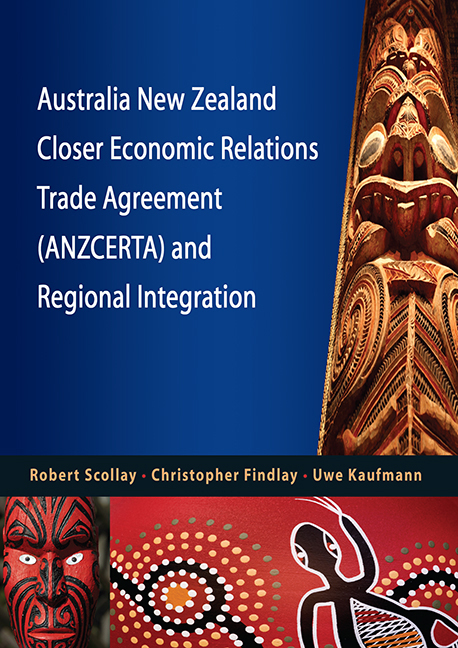Book contents
- Frontmatter
- Contents
- Foreword
- Australia New Zealand Closer Economic Relations Trade Agreement (Anzcerta) and Regional Integration
- Executive Summary
- 1 Introduction
- 2 Background
- 3 Pre-ANZCERTA Trade Arrangements
- 4 Early Years of ANZCERTA
- 5 Consolidation of ANZCERTA
- 6 Deepening Integration
- 7 Pursuit of a Single Economic Market (SEM)
- 8 Further Monetary Integration: A Monetary Union?
- 9 The Economic Effects of ANZCERTA
- 10 Conclusion
- References
- About the Authors
Executive Summary
from Australia New Zealand Closer Economic Relations Trade Agreement (Anzcerta) and Regional Integration
Published online by Cambridge University Press: 21 October 2015
- Frontmatter
- Contents
- Foreword
- Australia New Zealand Closer Economic Relations Trade Agreement (Anzcerta) and Regional Integration
- Executive Summary
- 1 Introduction
- 2 Background
- 3 Pre-ANZCERTA Trade Arrangements
- 4 Early Years of ANZCERTA
- 5 Consolidation of ANZCERTA
- 6 Deepening Integration
- 7 Pursuit of a Single Economic Market (SEM)
- 8 Further Monetary Integration: A Monetary Union?
- 9 The Economic Effects of ANZCERTA
- 10 Conclusion
- References
- About the Authors
Summary
Economic integration between Australia and New Zealand, with ANZCERTA as its central instrument, is today widely regarded as a success story. Tariffs and quantitative restrictions on bilateral trade in goods have been completely removed, trade in services between the two countries has been liberalized to a very large extent, and the citizens of both countries have long enjoyed the right to visit and work in each other's country without restriction. The absence of formal provisions for the liberalization of bilateral investment flows is usually qualified by nothing that the basically open foreign investment policies of both countries facilitate a relatively free flow of investment between them, to the extent that Australia is the largest source of foreign direct investment into New Zealand, and New Zealand is the sixth largest source of foreign direct investment into Australia.
A single government procurement market has been established across the two countries. There has been very substantial progress in the harmonization or mutual recognition of standards and occupational qualifications. Customs procedures have been streamlined between the two countries. There is a substantial degree of cooperation on biosecurity matters. Anti-dumping actions on trade between the two countries have been abolished. There has been some degree of harmonization of competition law, and further harmonization of business law is being actively pursued.
Since 2004 both countries have been committed to the progressive establishment of a Single Economic Market (SEM).
The process of integration, stretching for just over forty years, with ANZCERTA having been in force for twenty-six of those years, has, however, been far from smooth and automatic. There were many hesitations and difficulties during the early years of the process, and it is only in the last twenty years that momentum towards economic integration could be said to have been continuously sustained. Even over this latter period there has been a degree of selectivity in the issues that the two governments have chosen to address as part of the economic integration agenda, and there have been variations over time in the pace at which the overall integration agenda, and individual issues within that agenda, have been pursued.
- Type
- Chapter
- Information
- Australia New Zealand Closer Economic Relations Trade Agreement (ANZCERTA) and Regional Integration , pp. 3 - 17Publisher: ISEAS–Yusof Ishak InstitutePrint publication year: 2010

